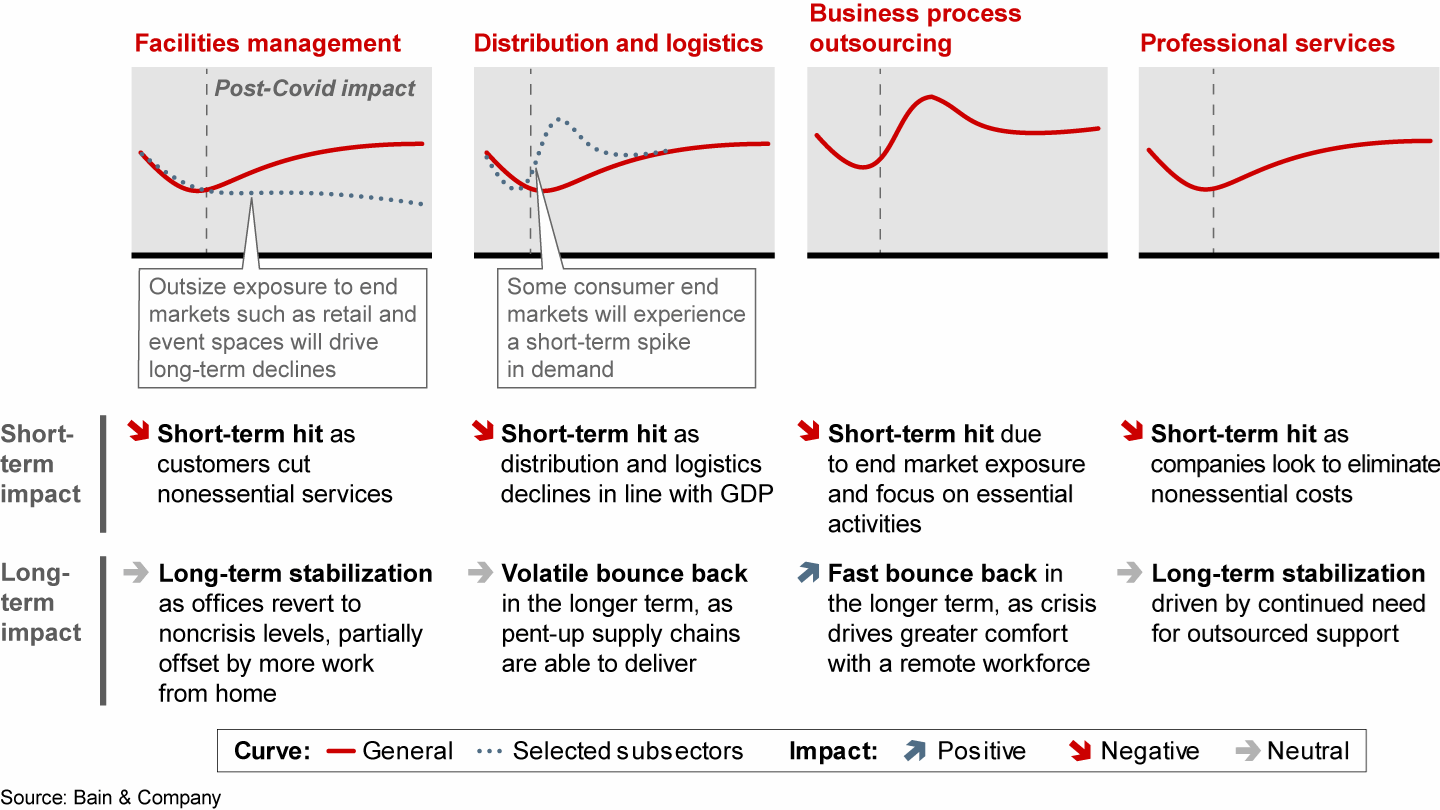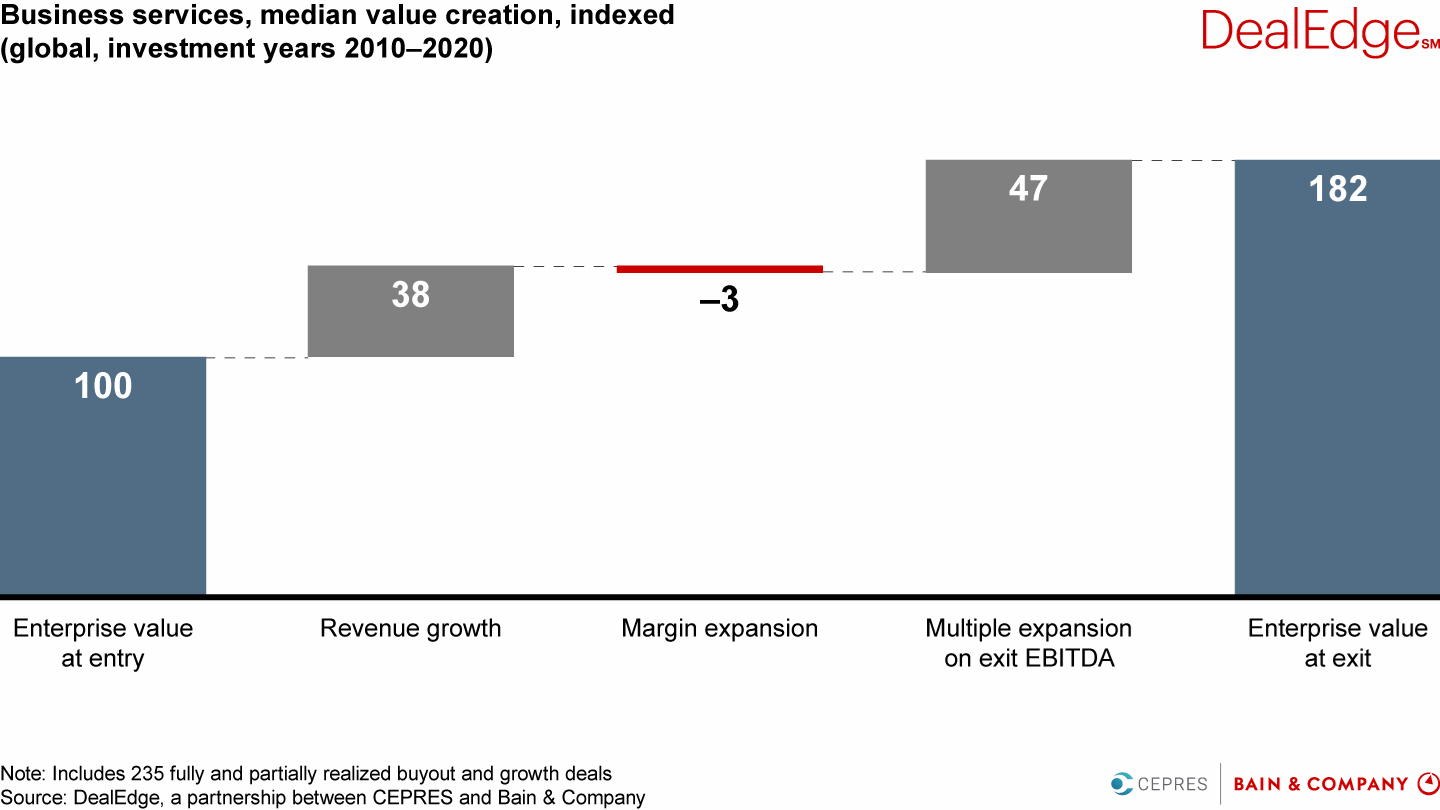論説

Since 2010, the business services sector has been among private equity’s most active hunting grounds. Over that period, it has accounted for 12% of investment value and 23% of deal count globally. PE funds have averaged more than 750 business services deals worth $48 billion each year.
The appeal is clear: The sector has enjoyed a strong set of technology-enabled growth trends made stronger by the long economic expansion. Chronic talent shortages and increased outsourcing of noncore business activities have spurred demand for everything from IT, legal and market analytics expertise to logistics, business process outsourcing (BPO) and janitorial services. PE investors have benefited from steady organic growth and the opportunity to execute lucrative buy-and-build strategies to create scale players. That, plus a healthy dose of multiple expansion, has led to strong, consistent returns.
But whether the momentum can continue, especially in the wake of the Covid-19 pandemic, will hinge on PE funds’ willingness to alter their investment approach to the sector.
A new ball game
It’s not that the future for business services isn’t still bright. While the sharp slowdown in global economic activity due to the pandemic will inevitably hurt short-term demand for outsourced services, the longer-term outlook in most subsectors remains relatively strong (see Figure 1). The challenge is that asset price multiples remain at record levels (as is the case for nearly all industries), suggesting that investors will need additional sources of upside in the future. It’s also true that many key sectors are already well along the outsourcing penetration curve, meaning the pace of growth may soften over time. Taken together, these issues suggest that creating the kind of value PE investors have become accustomed to will require deploying a new set of strategies.
Most business services sectors have taken a short-term hit from the Covid-19 crisis, but demand will likely recover over time


Breaking down which factors have contributed most to the sector’s impressive returns over the current cycle outlines the challenge (see Figure 2). Business services deals have relied almost exclusively on revenue growth (often via mergers and acquisitions) and multiple expansion; margin improvement hasn’t been a factor. The implication is clear: As top-line growth and multiple expansion become harder to generate—especially in a slowing economy—deal sponsors will have to work harder on businesses’ fundamentals to improve cash flow and generate returns.
Revenue growth and multiple expansion—not margin improvement—have historically driven returns in the business services sector


The good news is there’s ample opportunity to build value at most business services companies. The Covid slowdown, in fact, provides a chance to both rework cost structures and improve how services are delivered. Very often, BPO and professional services firms have been built through acquisition, and the race to increase scale and market share has been all consuming. Focusing on revenue growth has left less energy for things like integrating acquisitions, rationalizing G&A expenses, optimizing salesforce behaviors and integrating IT systems. Targets also have had little time to innovate with automation and digital technology to improve efficiencies and enhance services. Focusing on these internal functions can tee up a lot of quick wins, and over time, it can change the company’s earnings trajectory.
Creating value from the inside out
In our experience, four areas of focus can deliver the biggest impact: optimizing service delivery, improving the operating model, creating a more focused and efficient commercial organization, and applying digital technology to everything you do.
Service delivery. Depending on the business services subsector, full-time salaries can make up as much as 70% of the overall cost structure. So there is usually plenty of room for improvement when it comes to managing people and optimizing the processes they use to deliver services. Retraining call-center employees to handle varied tasks, for instance, can increase staffing flexibility and improve service at the same time. Offshoring certain processes and automating others can produce significant efficiencies. The wild card post-Covid will be how demand for services changes as companies adjust to the new order of things. But this can be a chance to get a jump on the competition for leadership teams that proactively anticipate change and innovate new ways to satisfy evolving customer needs.
Operating model. Business services companies, especially those stitched together through acquisition, haven’t had to worry much about the bread-and-butter business of optimizing the operating model to match the services they’re delivering. But rapid growth in complexity and a lack of organizational integration eventually create confusion and inefficiency, almost imperceptibly at first. Starting with a clean sheet of paper is key. The slowdown is a good time to zero-base offerings and processes—thinking through how services should be delivered vs. how they have been delivered in the past. It’s also a good time to define clear mission-critical roles and reporting lines, filling those roles with the right people, rationalizing incentives and instilling new behaviors. This kind of work in the trenches can create a more agile, fit-for-purpose organization.
Commercial excellence. Business services companies have traditionally focused on initiatives like salesforce optimization to improve top-line performance—and that should remain a priority. But there is also a cost angle to creating a smarter, more focused sales organization that has gotten less attention. It involves giving teams the tools, processes and training to help them be most efficient and productive. One example: data scraping tools that provide salespeople with core information about a prospect. Traditionally, teams relied on sales support to do this grunt work. But scraping is a more efficient way to capture the data.
Digital. As with any sector these days, technology is transforming business services, both on the product side and in the back office. The right investments can improve service delivery, enhance quality and cut costs at the same time. Not surprisingly, digital upstarts are also disrupting the status quo.
A good example is Modria, a unit of Tyler Technologies that, before Covid-19, had built a strong business in online dispute resolution. Specializing in e-commerce, insurance and other small claims–type disputes, Modria uses digital interfaces and artificial intelligence to reduce the cost of what is otherwise a very expensive, time-consuming process. The average case takes six days to resolve (vs. many weeks in court) and eliminates the need for expensive legal advice. Modria is currently focused on the US but is expanding in Canada and eying the EU and China. It is also opportunistic: As the Covid crisis hit, its parent introduced an offering called Tyler Virtual Court, which allowed shuttered courthouses to conduct sessions entirely online.
Faced with the threat of disruption, incumbent business services companies need to get faster and smarter. Ultimately, that may require a back-office transformation—integrating IT systems and migrating to the cloud—especially for buy-and-build companies that are getting by with a thicket of different legacy technologies. But a digital focus can also produce important wins on the front end, particularly through robotic process automation.
A large BPO company based in the UK faced a typical challenge. Having grown rapidly through acquisition with little attention to integration, the company eventually began to trip over its own cost structure and complexity. Setting it right required intervention on various fronts: a complete zero-basing of the G&A cost structure and a transformation of the operating model to deploy workforce tools and rationalize spans and layers. The company also optimized its IT systems by increasing offshore development and eliminating legacy systems.
What changed the game for this company and its clients, however, was building an internal capability dedicated to automating repetitive, mistake-prone processes that were both labor intensive and costly. The new capability was not an attempt to bring everything in house, but a center of automation excellence that could create partnerships, assemble resources and help scale automation across the company.
This has led to impressive savings. In a typical case, the company began managing the customer refund process for a client that got flooded with such requests each year. Previously, vetting the refunds was a complex manual exercise in sorting through claims and comparing them to documented facts, a mind-numbing process that required a dedicated group of customer service representatives. By building a robot to do the sorting automatically, the process became cheaper, faster and more accurate.
In another case, the service provider helped a healthcare client automate processes to calculate benefits, validate registrations and make sure cancer screening letters are sent on time to the right patients. Under the old system, the institution would produce a list of people who should get screening letters, and a team would send them manually. Not only was the process inefficient but the error rate for this crucial communication was unacceptably high. Automating the process with robotics had the triple benefit of eliminating human error, reducing clinical risk and cutting costs.
The post-Covid agenda
As with every sector across the global economy, the economic impact of the Covid-19 pandemic presents major challenges for business services companies. Yet it also offers a unique opening to reset your business for the next chapter of growth. The companies that accelerate out of the downturn will focus on several key questions as they chart their course over the next 12 to 24 months:
- What is the demand outlook for the specific services, customer segments and geographies in which this business competes?
- What do we have to do to win amid the change—i.e., what new channels are required, or how do service offerings need to evolve?
- Given these changes, how should we deliver services differently? What changes to the operating model are required? What are the cost takeout opportunities? How much investment do we need?
- What is the digital roadmap to get us there? Can we use technology to engage more effectively with customers, enhance delivery, drive out cost or improve the value proposition?
Business services still offers private equity investors the opportunity to generate strong returns. But as the historical sources of value ebb in a weakening economy, the formula for success is changing, too. To win in a more difficult environment, funds will have to think harder about how to use digital and operational excellence to create stronger, more efficient competitors.